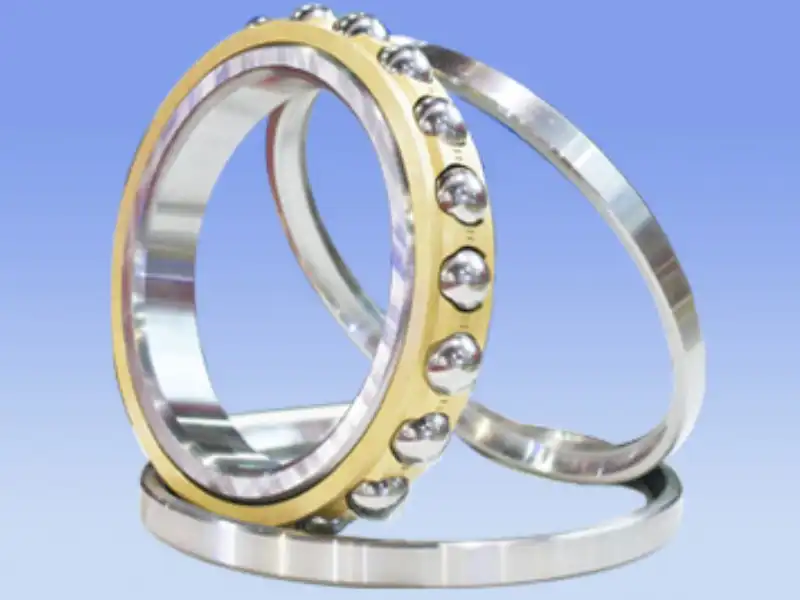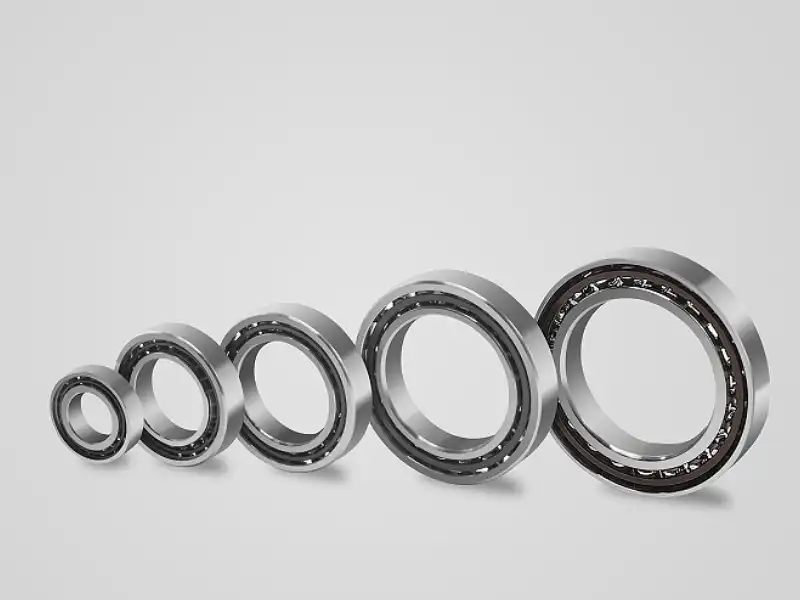How to Install a Single Row Angular Contact Ball Bearing?
The installation of a single row angular contact ball bearing is a critical process that demands precision, proper techniques, and thorough understanding of bearing components. These specialized bearings are designed to handle both radial and axial loads in one direction, making them essential components in various mechanical applications, from machine tools to aerospace equipment. Proper installation is crucial as it directly impacts the bearing's performance, reliability, and service life. This comprehensive guide will walk you through the essential aspects of angular contact ball bearing installation, ensuring optimal performance and longevity of your machinery.

What Are the Key Preparation Steps Before Installing Angular Contact Ball Bearings?
Before initiating the installation process, thorough preparation is essential to ensure a successful bearing mounting. The preparation phase involves several critical steps that set the foundation for optimal bearing performance. First, the workspace must be immaculately clean and well-organized, as contamination is one of the leading causes of premature bearing failure. This includes cleaning the shaft, housing, and all associated components with appropriate cleaning agents to remove any dirt, debris, or protective coatings.
The bearing itself requires careful inspection before installation. Check for any visible damage, such as scratches, dents, or rust spots. The Single Row Angular Contact Ball Bearing should be kept in its original packaging until immediately before installation to prevent contamination. All necessary tools and equipment should be gathered and verified to be in good condition. This includes measuring instruments like micrometers and dial indicators, heating equipment if thermal mounting is required, and appropriate pressing tools.
Temperature control is another crucial aspect of preparation. Both the bearing and the housing should be at room temperature unless specific mounting procedures require otherwise. If thermal mounting is necessary, precise temperature control is essential to prevent overheating, which can alter the bearing's metallurgical properties or damage its seals and cages.
Documentation and specifications must be carefully reviewed, including checking the correct bearing orientation, required fits and clearances, and any special mounting instructions from the manufacturer. This information is crucial as different applications may require specific mounting arrangements or techniques. The shaft and housing dimensions should be verified against the specifications to ensure proper fits.
Another vital preparation step is the assessment of lubrication requirements. The type and quantity of lubricant should be determined based on the application requirements and manufacturer recommendations. The lubricant should be clean and fresh, and appropriate for the operating conditions the bearing will face.
What Is the Correct Installation Procedure for Angular Contact Ball Bearings?

The installation procedure for angular contact ball bearings must follow a systematic approach to ensure proper mounting and optimal performance. The process begins with confirming the bearing orientation, as these bearings are directional and must be mounted correctly to handle the intended axial loads. The bearing's wider inner ring face typically faces the direction of the primary axial load.
When mounting the Single Row Angular Contact Ball Bearing onto the shaft, it's crucial to apply force only to the ring being fitted. For shaft mounting, force should be applied to the inner ring, while housing mounting requires force application to the outer ring. This prevents damage to the rolling elements and raceways. If thermal mounting is used, the bearing should be heated uniformly to approximately 80-90°C above the shaft temperature, but never exceeding 120°C as this can affect the bearing's material properties.
The mounting force should be applied gradually and evenly, preferably using appropriate mounting tools such as a hydraulic press or an impact-free hammer with a suitable drift. During the pressing operation, the force should be applied steadily without interruption until the bearing is fully seated. It's essential to ensure that the bearing remains square to the shaft throughout the mounting process to prevent misalignment.
Once mounted, the bearing position should be verified using appropriate measuring tools. This includes checking the mounted clearance, if applicable, and ensuring proper seating against shaft and housing shoulders. Any specified preload must be carefully applied according to the manufacturer's instructions, as incorrect preload can significantly affect bearing performance and life.
The final steps involve securing the bearing in position using appropriate retention methods such as lock nuts, locking plates, or circlips. These components must be installed correctly and torqued to the specified values. The bearing assembly should then be rotated by hand to check for smooth operation and any unusual resistance or noise that might indicate mounting problems.

How Can You Verify Proper Installation and Maintain Angular Contact Ball Bearings?
After installation, proper verification and maintenance procedures are crucial for ensuring optimal Single Row Angular Contact Ball Bearing performance and longevity. The verification process begins with a thorough inspection of the mounted bearing assembly. This includes checking for proper seating, correct alignment, and secure retention of all components.
Rotation tests are essential for verifying proper installation. The bearing should rotate smoothly and quietly when turned by hand. Any roughness, binding, or unusual sounds could indicate installation problems such as misalignment, improper mounting force, or contamination. Running temperature should be monitored during initial operation, as excessive heat generation might suggest mounting issues or inadequate lubrication.
Clearance and preload measurements should be taken and compared against specifications. This can be done using dial indicators, feeler gauges, or specialized measuring equipment depending on the application requirements. Any deviations from specified values must be investigated and corrected before putting the equipment into service.
Regular maintenance is crucial for prolonging bearing life. This includes implementing a proper lubrication schedule based on operating conditions and manufacturer recommendations. The lubricant type, quantity, and relubrication intervals should be carefully monitored and maintained. Contamination control measures, such as proper sealing and regular cleaning of the surrounding area, are essential for preventing premature bearing failure.
Vibration monitoring can provide early warning of developing problems. Regular vibration measurements and analysis can help detect issues such as misalignment, unbalance, or bearing damage before they lead to failure. Temperature monitoring during operation can also indicate potential problems, as unusual temperature increases might suggest lubrication issues or excessive loading.
Documentation of installation procedures, maintenance activities, and operating parameters is important for tracking Single Row Angular Contact Ball Bearing performance and troubleshooting any issues that may arise. This information can be valuable for future reference and for optimizing maintenance procedures.
Luoyang Huigong Bearing Technology Co., Ltd. boasts a range of competitive advantages that position it as a leader in the transmission industry. Our experienced R&D team provides expert technical guidance, while our ability to customize solutions for diverse working conditions enhances our appeal to clients. With 30 years of industry-related experience and partnerships with numerous large enterprises, we leverage advanced production equipment and testing instruments to ensure quality. Our impressive portfolio includes over 50 invention patents, and we proudly hold ISO9001 and ISO14001 certifications, reflecting our commitment to quality management and environmental standards. Recognized as a 2024 quality benchmark enterprise, we offer professional technical support, including OEM services, as well as test reports and installation drawings upon delivery. Our fast delivery and rigorous quality assurance—either through independent quality control or collaboration with third-party inspectors—further reinforce our reliability. With many successful collaborations domestically and internationally, we invite you to learn more about our products by contacting CHG at sale@chg-bearing.com or calling our hotline at +86-0379-65793878.
References
1. SKF Bearing Installation and Maintenance Guide (2023)
2. NSK Technical Report: Angular Contact Ball Bearings Installation
3. Timken Engineering Manual: Proper Mounting Procedures
4. NTN-SNR Bearing Installation Best Practices Guide
5. FAG Mounting of Rolling Bearings Technical Guide
6. JTEKT Engineering Journal: Angular Contact Ball Bearing Technology
7. American Bearing Manufacturers Association Standards
8. ISO 15242-1:2004 Rolling bearings - Measuring methods for vibration
9. International Journal of Mechanical Engineering: Bearing Installation Techniques
10. Machinery's Handbook 31st Edition: Bearing Installation and Maintenance

